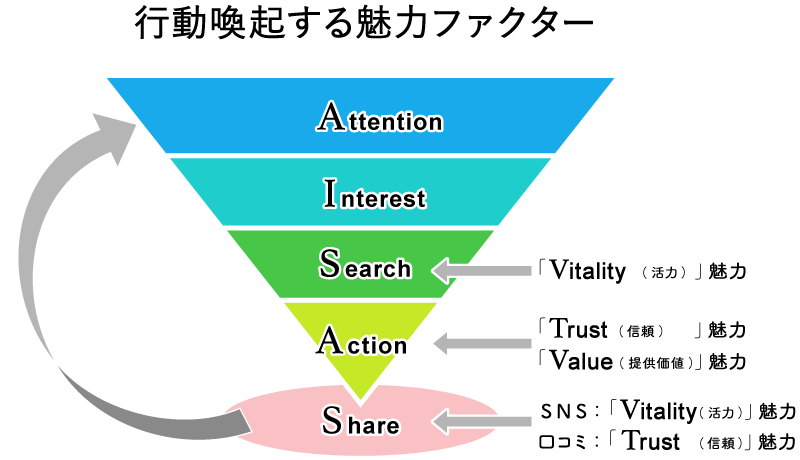The Corporate Public Relations Strategy Institute has designed a model categorizing corporate appeal into three factors—"Human Appeal," "Corporate Appeal," and "Product Appeal"—and has conducted extensive research and surveys. This classification is from a corporate perspective, as it allows executives and brand managers to more easily understand stakeholder relationships and formulate countermeasures.
Each of these three appeal factors is subdivided into 12 items, totaling 36 questions surveyed among 10,000 consumers.
This time, we utilized these survey results to conduct exploratory analysis seeking factors from the consumer perspective and examined their relationship with search and purchasing behavior.
When we performed a cross-sectional factor analysis of all 36 appeal items—originally categorized by corporate executives and brand managers into "Human Appeal," "Corporate Appeal," and "Product Appeal"—based on the consumer survey results, three new consumer-perspective appeal factors emerged: "Trust," "Vitality," and "Value."
The first factor, named "Trust," showed high factor loadings for items such as "having serious and trustworthy employees," "having solid risk preparedness," "being deeply rooted in the community and contributing to its development," and "having a stable revenue base."
The second factor, named "Vitality," showed high factor loadings for items such as "actively supporting entrepreneurs and venture companies," "having a meritocratic workplace culture," "expanding business through proactive investments like M&A," and "fostering an open corporate culture that encourages free discussion."
The third factor is named "Value," as it shows high factor loadings for items such as "providing products/services with a large core fan base" and "providing products/services with originality and creativity."
■ How do consumers act after finding a company appealing?
On the other hand, what purchasing actions do consumers take after finding a company appealing? Analyzing the relationship between consumer purchasing behavior and the aforementioned appeal factors reveals the following:

★ = Strong relationship ○ = Relationship exists
※The above table is simplified for clarity. For detailed analysis data, please refer to the paper presented at the Marketing Association conference.
Key points from the survey analysis are as follows:
・To encourage consumers to take search actions like online searches or visiting company websites, Vitality-related content such as "merit-based workplace culture" and "proactive investments like M&A" is crucial.
・To move consumers toward actions like visiting to see products/services or purchasing, "Value"-related content is obviously important, but the importance of "Trust"-related content—such as "sincere and trustworthy employees," "risk preparedness," and "community engagement"—is also clear.
・Among sharing behaviors, Vitality-related content pairs well with social media posts, while Trust-related content is more effective for real-world sharing (word-of-mouth, etc.).
■Why not take stock of your company's compelling actions (facts)?
Even when videos spread and generate reasonable buzz, companies face various brand challenges: weak conversion to sales, stagnant buyer engagement rates, or limited word-of-mouth growth. It's crucial to reassess your company's challenges within the marketing funnel (like the AISAS model) and evaluate whether the characteristics of your content align appropriately with your brand issues.
At the Corporate Public Relations Strategy Institute, we define appeal as "something that springs from the company's inner essence and is recognized externally through its actions." Beyond the image formed through advertising and promotion, building a track record of actual corporate actions (facts) creates a synergistic effect. To achieve this, we recommend using tools like the Appeal Model to take stock of gaps in corporate actions (facts) within your management and brand strategies, thereby visualizing the company's appeal elements.
We firmly believe these activities represent the first step toward efficiently advancing branding efforts to build a favorable business environment for your company.
We sincerely hope this series proves useful for your brand strategy.
For further details, please contact the Corporate Public Relations Strategy Institute (within Dentsu Inc. Public Relations).
*This article is based on a research paper that received the Best Paper Award at the Japan Marketing Association's research conference, "Marketing Conference 2017." For the full research paper, please refer to "An Examination of Corporate Attractiveness Factors and Purchasing Behavior. "
Koichi Kitami (Associate Professor, Faculty of Urban Life Studies, Tokyo City University), Kanji Sakai (Director, Dentsu Inc. Public Relations), Yoshiyuki Suetsugu (Manager, Dentsu Inc. Public Relations)







